0
1.2.1 DET DANSKE RIGE TAGER FORM
-
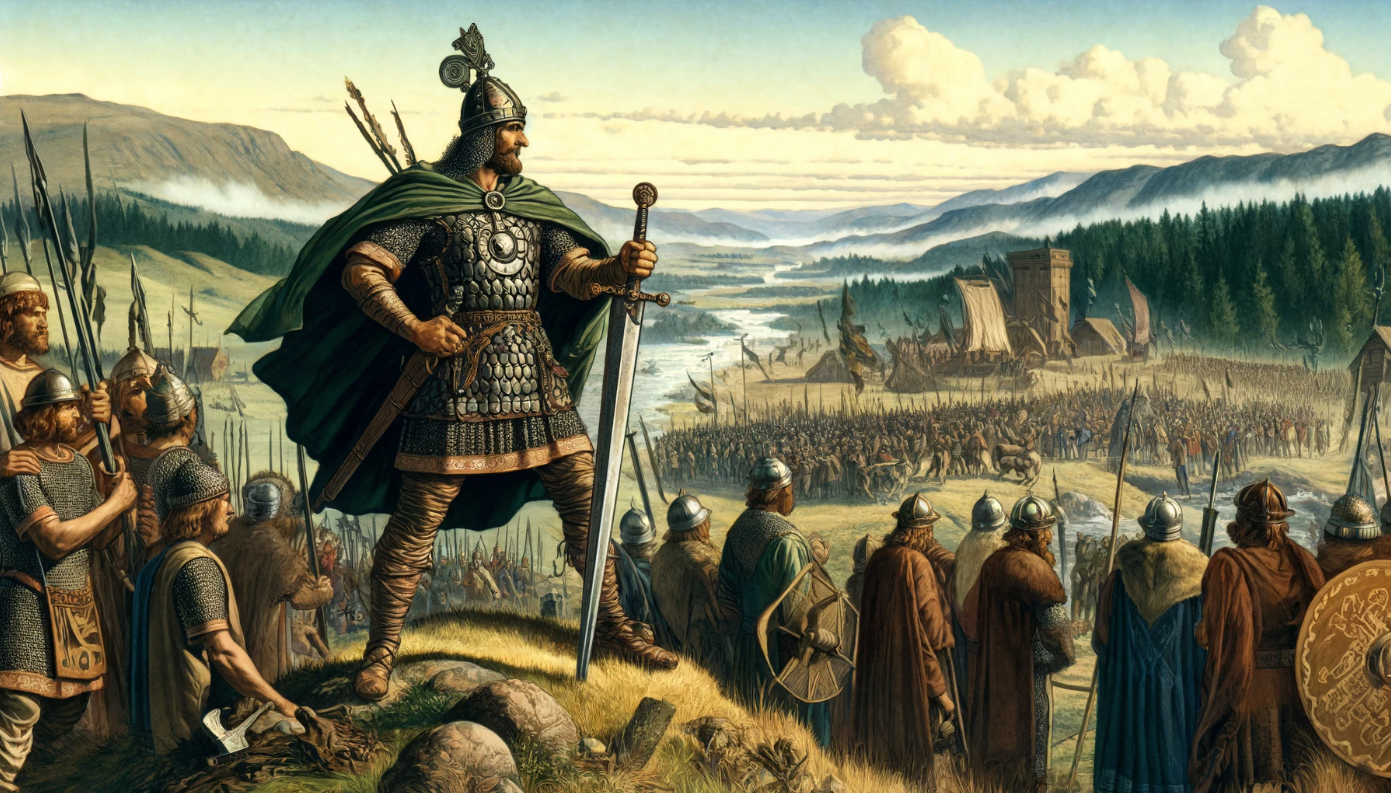
Circa 700
Formation of the Danish Kingdom
Angantyr, the first known king, started to unify what later became Denmark.
-
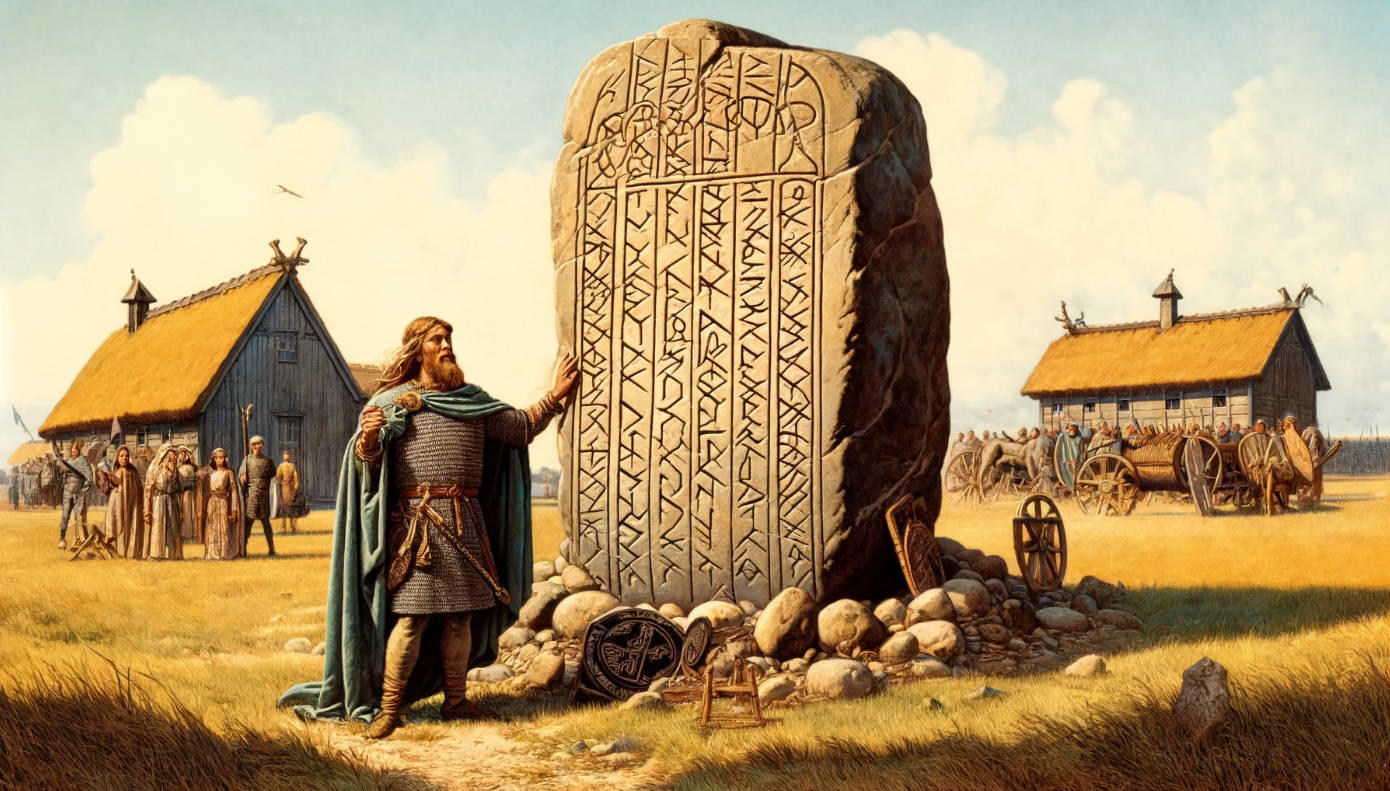
Circa 955
First use of the name 'Denmark'
Gorm den Gamle raised a runestone in Jelling to honor his wife Thyra, using the term 'Danmark' within the country’s borders for the first time
-
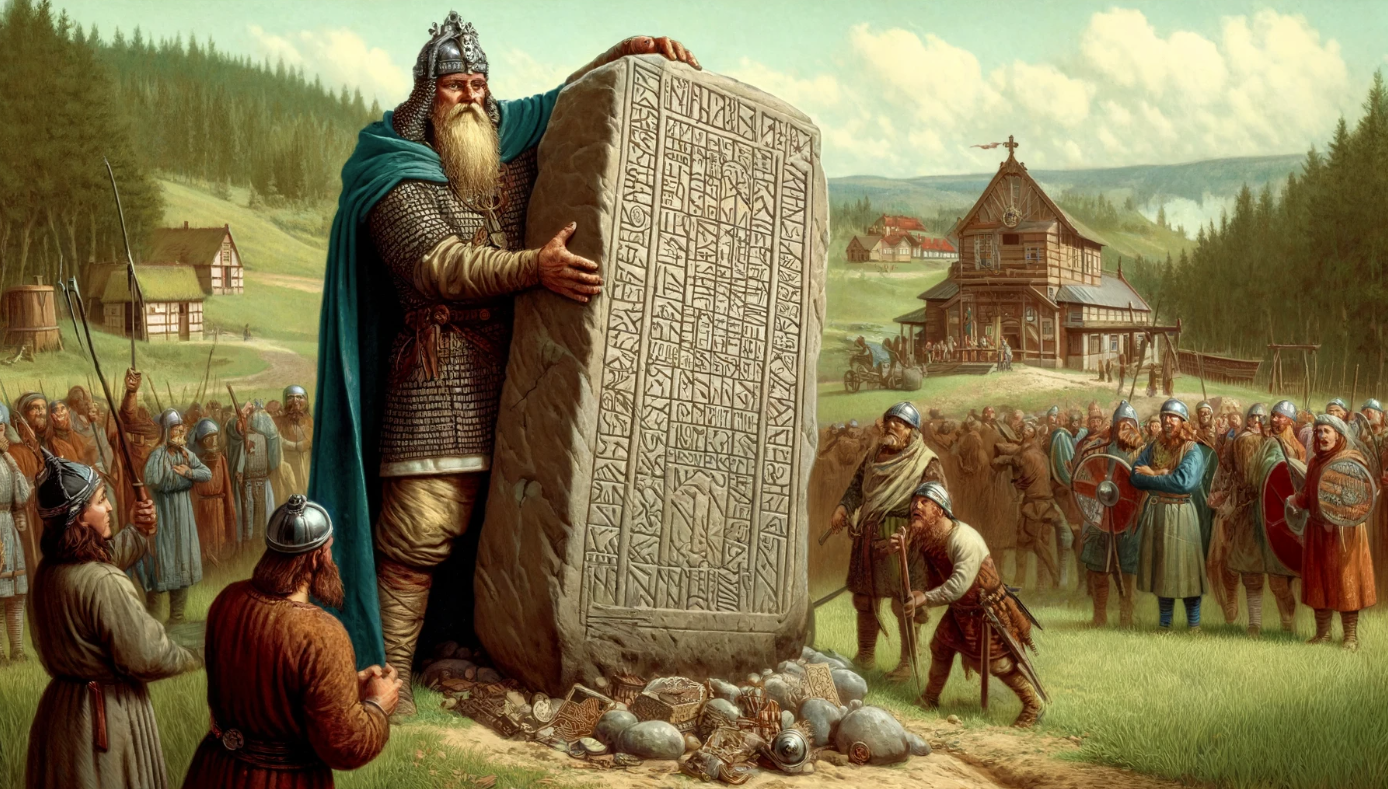
Circa 965
Consolidation of Danish Kingdom under Harald Blåtand
Harald Blåtand, son of Gorm and Thyra, raised a runestone marking his reign over Danmark and parts of Norway. He is recognized as the first king to rule all of Denmark
-
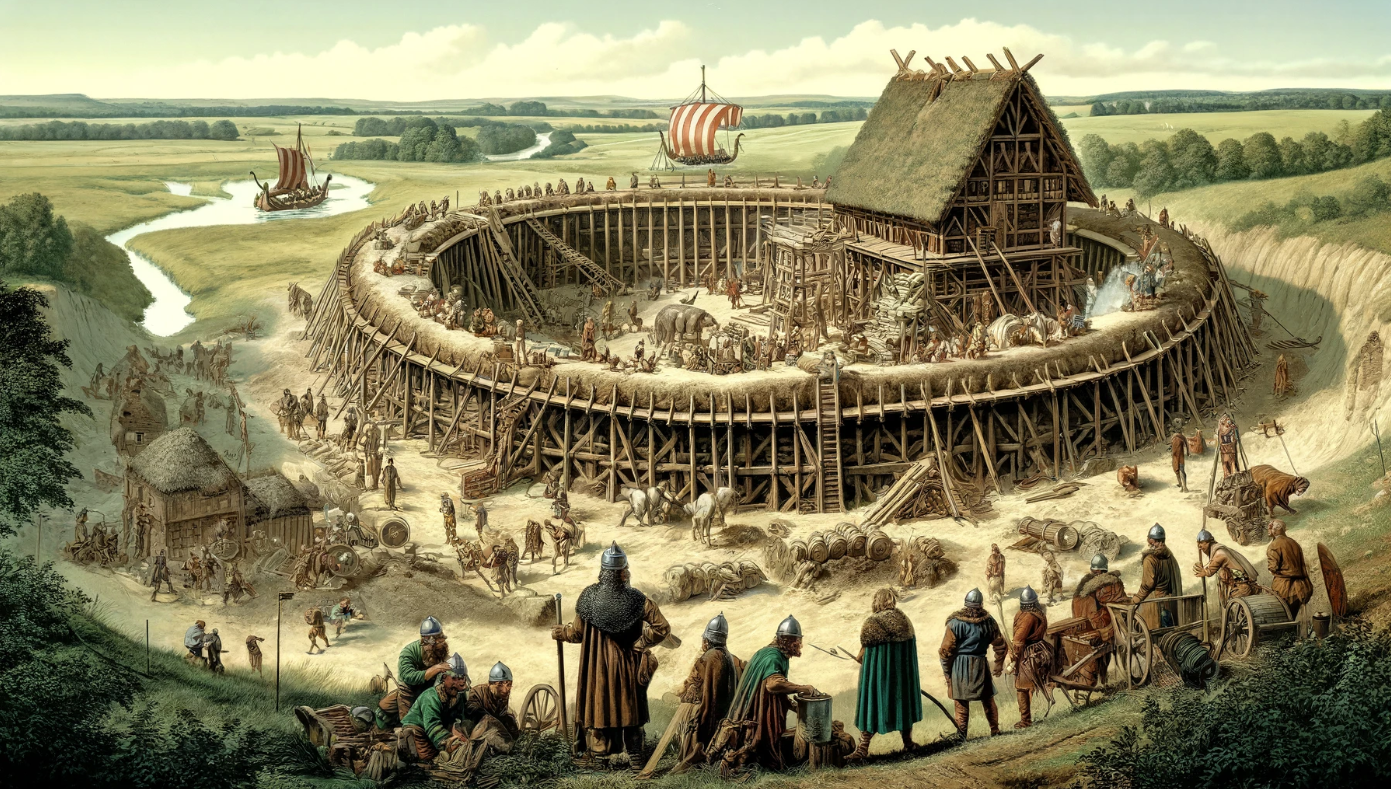
Circa 980
Construction of Ringborge
Harald Blåtand built several ring fortresses such as Trelleborg and Aggersborg as part of strengthening the kingdom’s defense against enemies.
1.2.2 VIKINGERNES KONTAKT MED OMVERDENEN
-
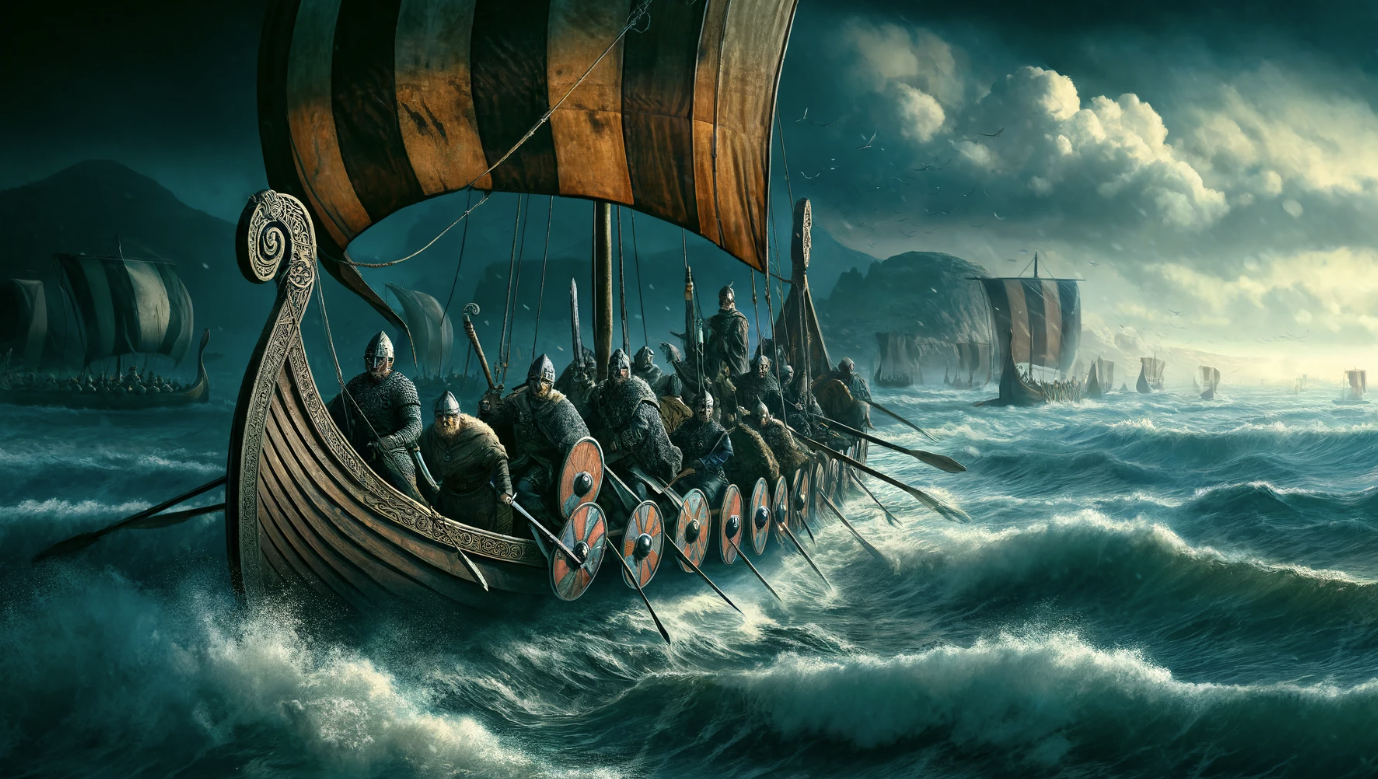
9th Century
Viking Expeditions Across Europe
Danish Vikings embarked on raids across Europe, including England and France, reaching as far as Konstantinopel. These expeditions often involved plundering monasteries and cities and demanding tribute from local populations.
-
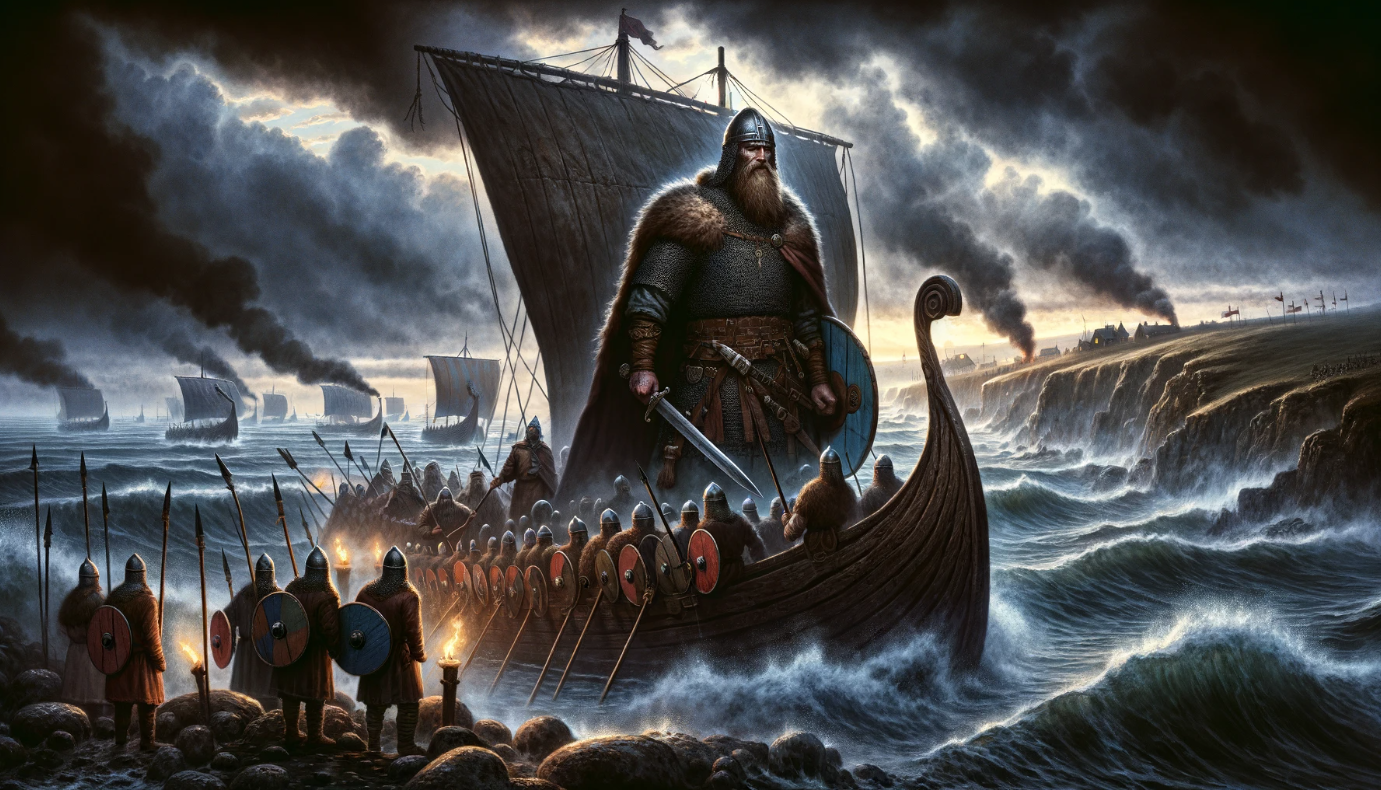
1013
Svend Tveskæg's Conquest of England
Svend Tveskæg conquered England and was declared king, marking a significant expansion of Danish influence in Europe.
-
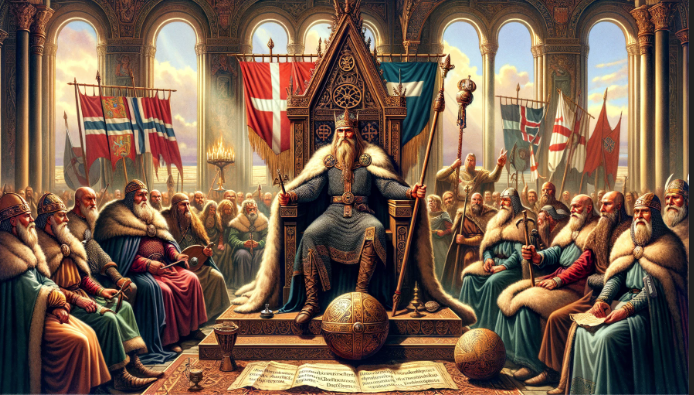
1018-1035
Reign of Knud den Store
Knud den Store ruled over England and Norge, overseeing the largest extent of the Viking empire, though it quickly fragmented after his reign.
1.3.1 MAGTKAMP MELLEM KONGE, ADEL OG KIRKE
-

1086
Assassination of Knud den Hellige
Knud den Hellige was assassinated in 1086 in Sankt Albani Kirke, Odense by prominent stormænd, who were the wealthiest men in the country. The stormænd were disgruntled over having to pay fines to the king for non-participation in military service. This event marked a significant weakening of the kongemagt, illustrating that future kings could only govern through negotiated agreements with the stormænd.
-

1648
Signing and Annulment of the Last Håndfæstning
The last håndfæstning was signed by Frederik den 3. in 1648, which was later annulled during the transition to an enevældigt arvekongedømme between 1660-61. This marked the end of the practice where Danish kings had to govern in agreement with the stormænd, centralizing royal authority.
-
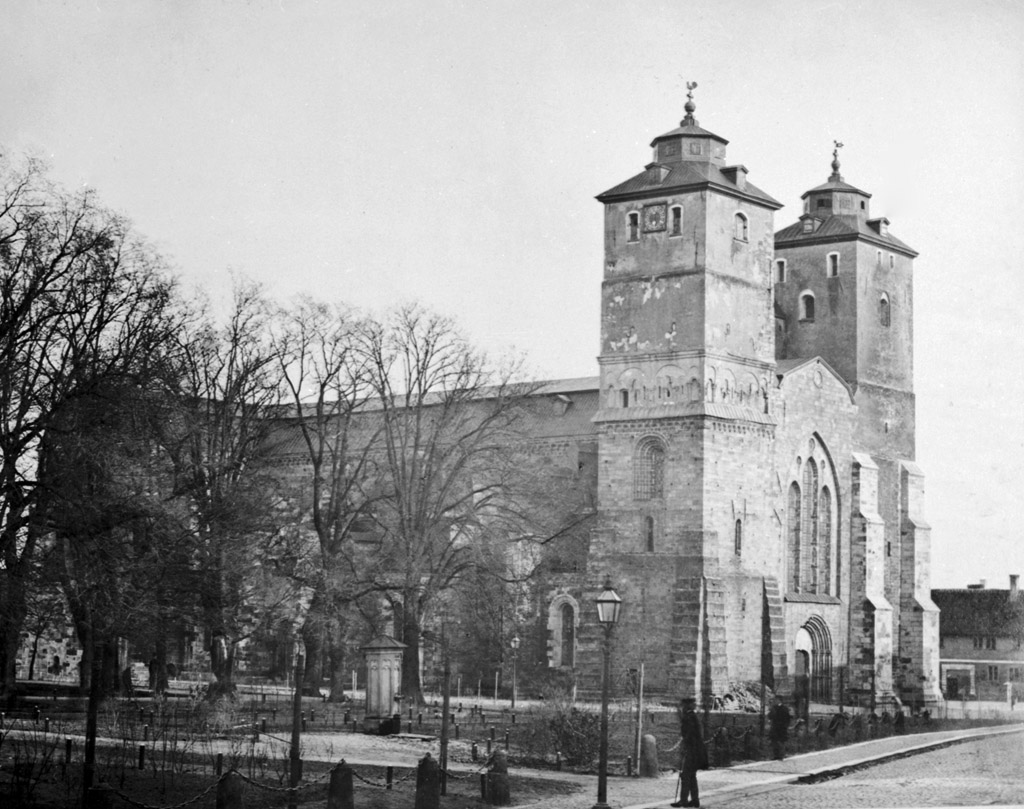
1103
Establishment of the Archbishopric of Lund
In 1103, Lund, then part of Denmark and located in Skåne (which was Danish territory until 1658), was granted its own archbishop, thereby placing all of the Nordic region under its ecclesiastical jurisdiction. This marked the emergence of an independent ecclesiastical territory in the North, directly under the authority of the Pope in Rome and independent from the influence of the German emperors.
-
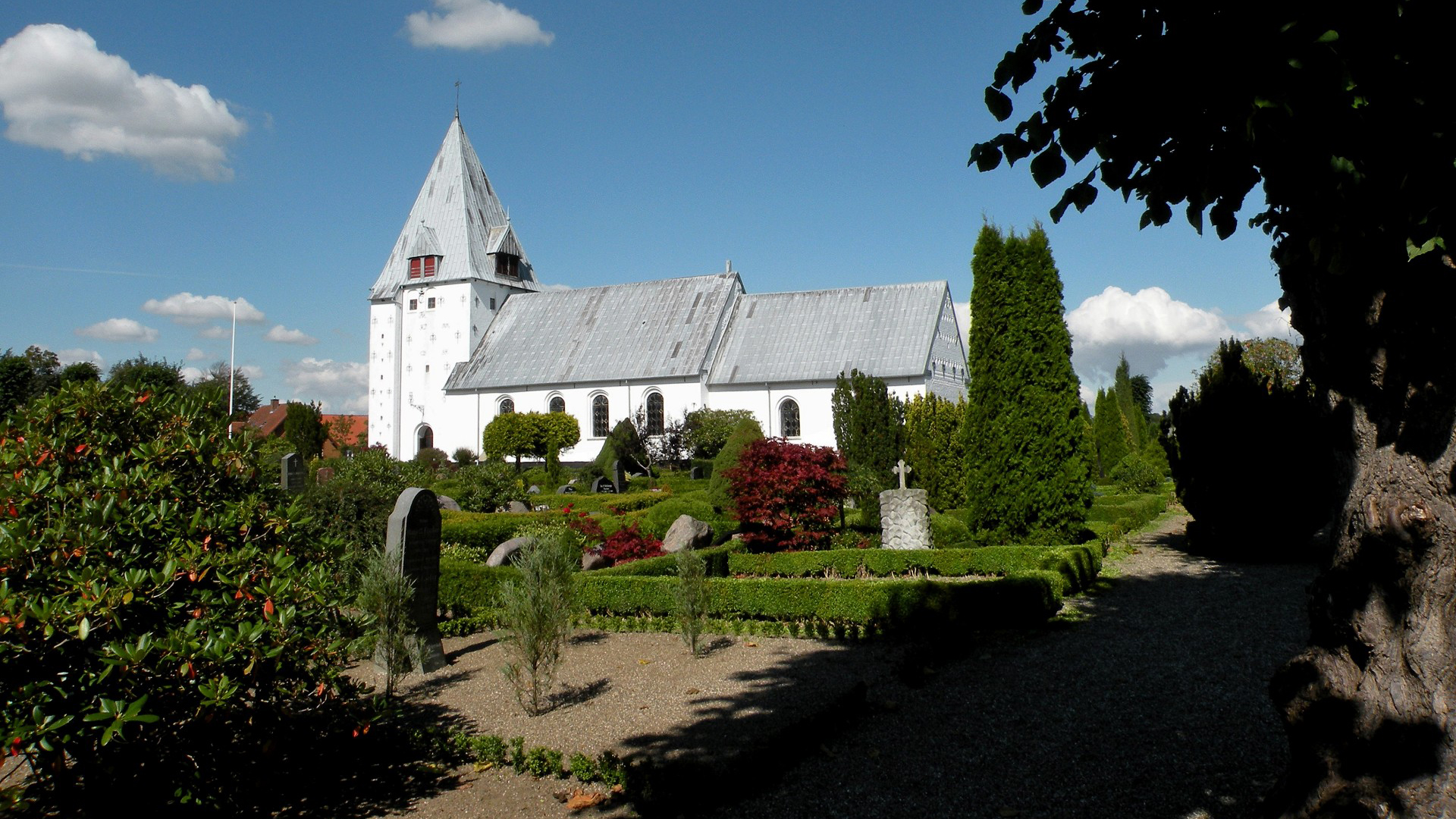
circa 1250
Expansion of the Church in Medieval Denmark
By around 1250, the Church had become a dominant force in Danish society, commanding significant influence over daily life, beliefs, and moral standards. Approximately 3,000 churches had been built across Denmark, serving as centers of faith in towns and villages. The Church mandated tithes, constituting one-tenth of harvests or production, and offered indulgences (aflad) for sins, often in exchange for monetary contributions. Regular Sunday masses facilitated reconciliation between God and the congregation.
-
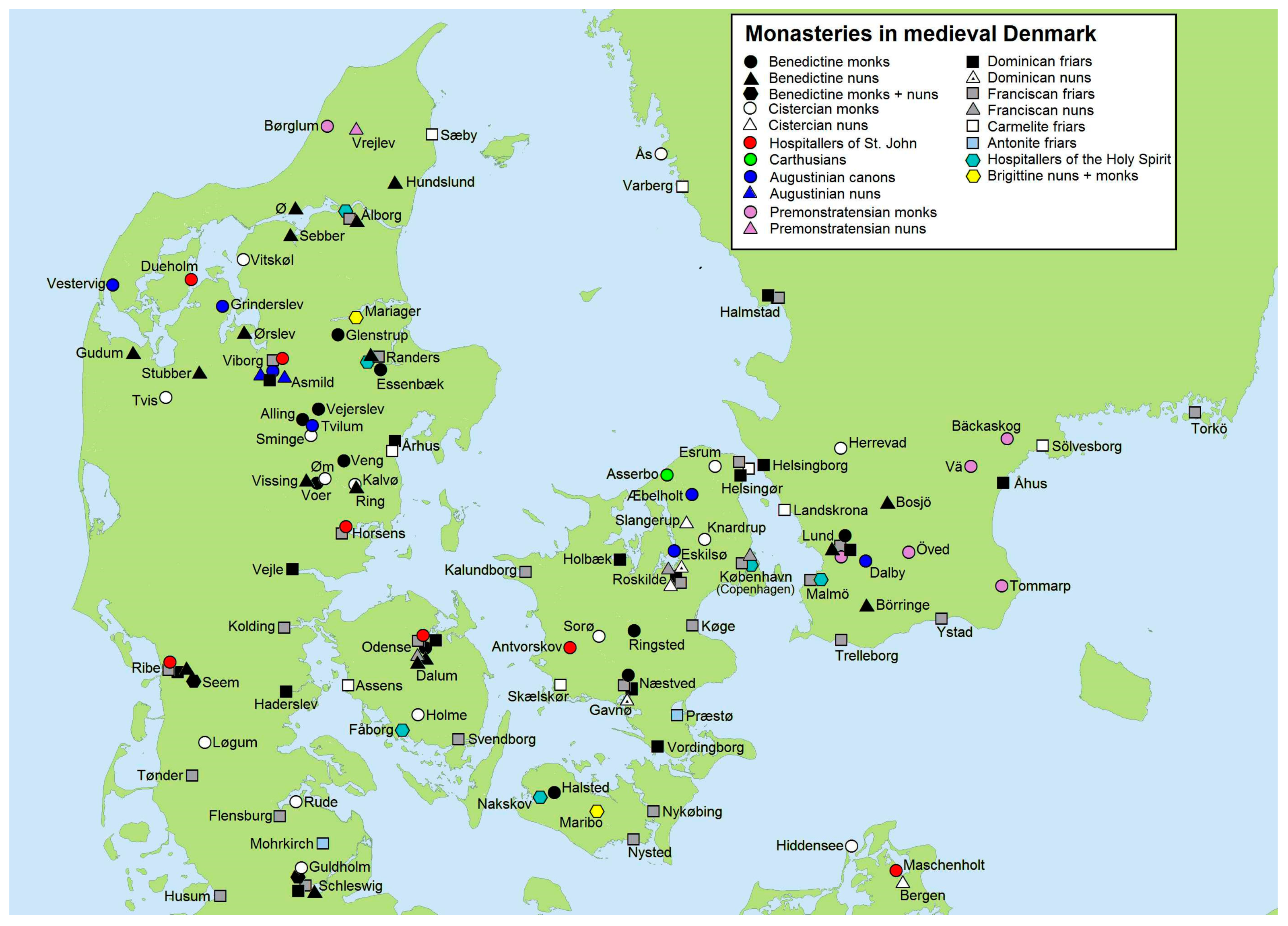
circa 1250
Establishment of Monasteries in Denmark
Alongside churches, numerous monasteries were constructed in Denmark, where monks and nuns pursued devout Christian lives. These monasteries often cared for the sick and the poor, enhancing the Church's role in societal welfare. The Catholic Church's ownership of extensive land and its stature as an international organization significantly influenced Danish and European politics, necessitating alignment from Danish kings.
-

1241
Jyske Lov
During a period of renewed strength in the Danish monarchy from the mid-12th to mid-13th century, Jyske Lov was established in 1241 as a landmark legal code, reflecting the centralization of legal authority under the monarchy. This code significantly moved Danish jurisprudence away from the customary law and practices of familial retribution, commonly known as blood vengeance. Jyske Lov, notable for its introduction with the maxim 'Med lov skal man land bygge' (With law shall the land be built), initially applied only to Jutland but laid foundational principles that were later incorporated into the Danske Lov of 1683, creating a unified legal framework for all of Denmark.
-

1219
Danish Crusade to Estonia
In 1219, Danish kings led a series of crusades in the Baltic region, aiming to convert pagan communities to Christianity. One of the most notable of these crusades was directed at Estonia. During a battle in Tallinn, it is legend that the Danish flag, Dannebrog, miraculously fell from the sky, which is said to have led to the Danish victory in the battle.
1.3.2 PEST, GENOPBYGNING OG KALMARUNION
-

1340-1375
Reign of Valdemar Atterdag and the Black Death
During Valdemar Atterdag's reign from 1340 to 1375, Denmark experienced a resurgence of state power after a period marked by division and civil war. The Black Death, or Den Sorte Død, struck Europe around 1350, devastating up to half of the population. The catastrophe inadvertently strengthened the king's power as he seized lands from those who died from the plague, consolidating royal control over the territory.
-

1397
Formation of the Kalmar Union
In 1397, Margrete I successfully united Denmark, Norway, and Sweden under the Kalmar Union, with the treaty signed in Kalmar, Sweden. This union established Denmark as the dominant power. While Sweden exited the union in 1523, Norway remained part of it with Denmark until 1814, highlighting a significant period of Nordic political unity.
1.4.1 REFORMATIONEN
-
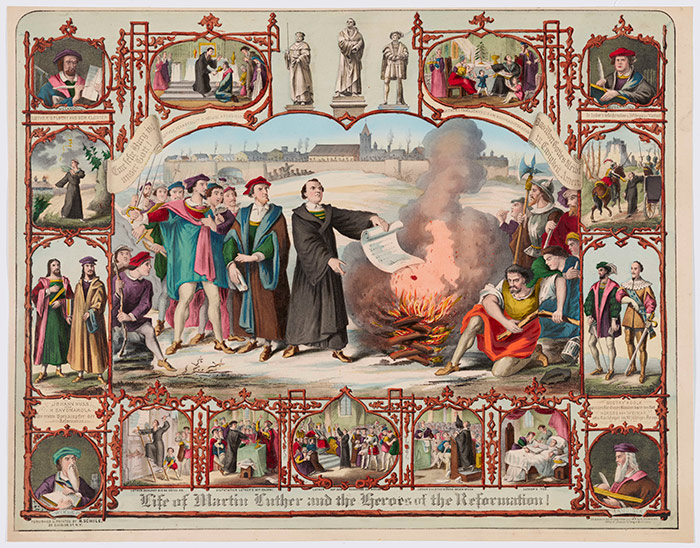
circa 1500
Rise of Protestantism and its Impact on the Danish Church
Around the year 1500, the power of the Catholic Church in Denmark, which was part of the broader Catholic Church under the Pope in Rome, began to face significant challenges from various movements aiming to reform the church. These movements were collectively known as Protestant. Led by the German monk Martin Luther, this reformation movement resulted in a large part of Northern Europe, including Denmark, breaking away from papal authority. This led to the establishment of independent Protestant churches that worked in close collaboration with local kings and princes.
-
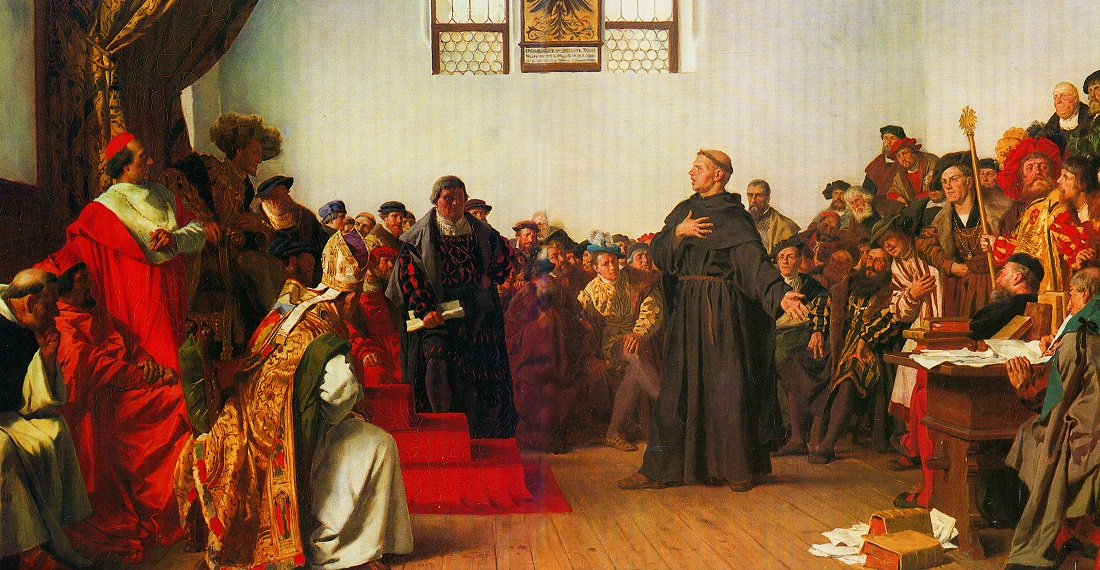
1520s
Spread of Lutheranism in Denmark
In the 1520s, Martin Luther's ideas reached Denmark, primarily propagated by the priest Hans Tausen (1494-1561). These ideas emphasized that salvation could only be achieved through faith alone, and not through good deeds or the purchase of indulgences. The discussions about Christianity rapidly evolved into a popular uprising against the wealthy and powerful Catholic Church.
-

1534
Outbreak of Civil War in Denmark
In 1534, a civil war erupted in Denmark between the Catholic Church's authorities and the supporters of Protestantism. This conflict was fundamentally driven by religious disputes, as the Protestant movement sought to implement reforms based on Martin Luther's teachings against the established Catholic power.
-

1536
Formal Establishment of Protestantism in Denmark
In 1536, following a civil war between the Catholic authorities and Protestant supporters, Protestantism under the leadership of King Christian III prevailed. This year marked the formal introduction of the Reformation in Denmark, based on Martin Luther's doctrines. The Danish Church transitioned from papal to royal authority, significantly reducing its political power. The Catholic Church's assets and lands were appropriated by the monarchy, and monasteries were closed. The shift included the translation of the Bible into Danish and conducting church services solely in Danish, making Christianity accessible to the general populace in their native language.
1.4.2 CHRISTIAN DEN 4. OG SVENSKEKRIGENE
-
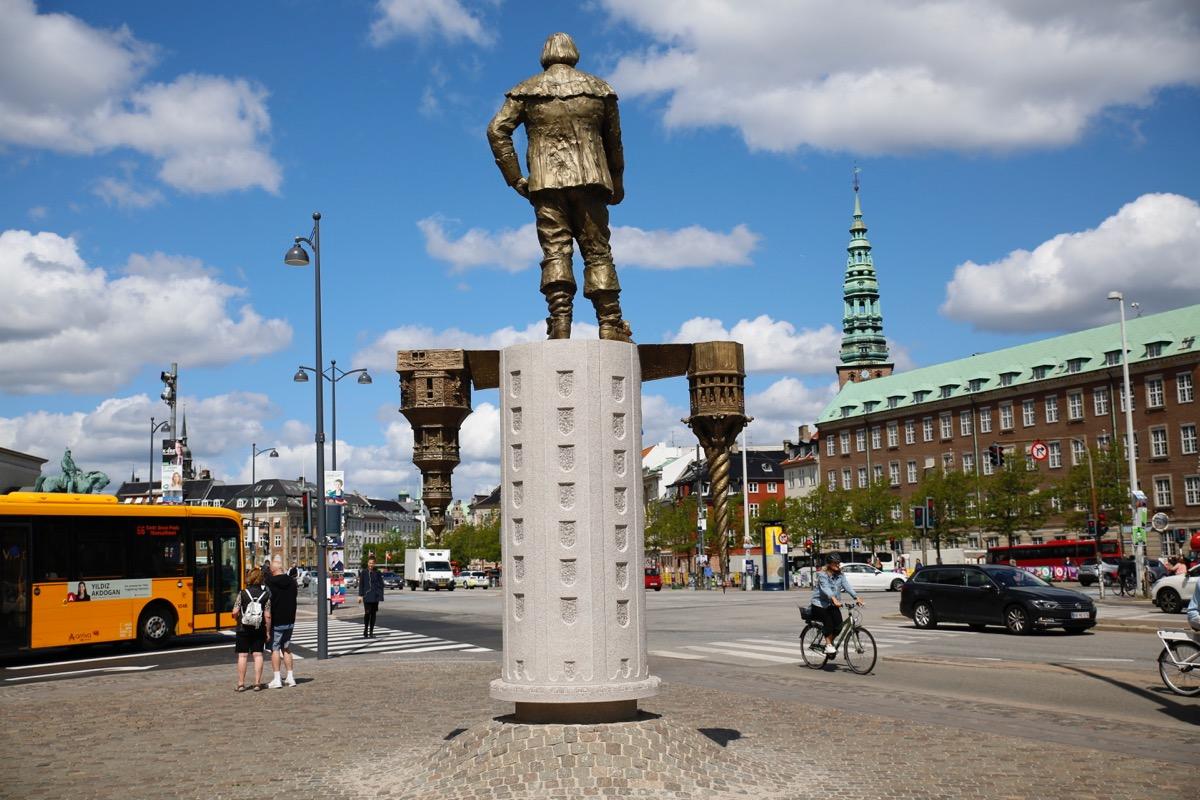
early 1600s
Architectural and Urban Contributions of King Christian IV
King Christian IV of Denmark, who reigned from 1588 to 1648, made significant contributions to architecture and urban development during the first half of the 17th century. He was responsible for the construction of iconic buildings in and around Copenhagen, including Frederiksborg Slot, Københavns Børs, Rosenborg Slot, and Rundetårn. Additionally, he founded several cities, including Kristianstad in Skåne, Kristiansand in Norway, and Kristiania (now known as Oslo), the current capital of Norway.
-

1625-1629
Danish Involvement in the Thirty Years' War and Shift in Baltic Power
During the reign of King Christian IV, Denmark's military and territorial ambitions faced setbacks. Notably, from 1625 to 1629, Christian IV involved Denmark in the Thirty Years' War, a major European conflict primarily taking place in Germany. The war, which lasted from 1618 to 1648, saw Denmark suffer a significant military defeat in 1626. By the time Denmark withdrew from the war in 1629, Sweden had emerged as the dominant power in the Baltic region, altering the balance of power that Denmark once held.
-
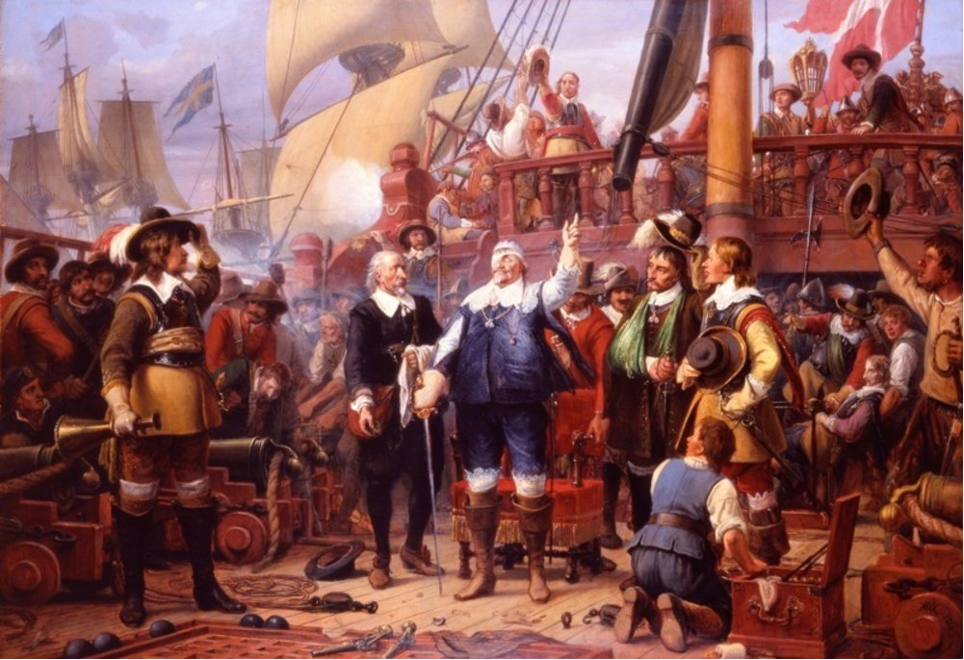
1643-1645
Swedish-Danish War and Territorial Losses for Denmark
The strained relations between Denmark and Sweden during King Christian IV's reign escalated into open conflict when Sweden attacked Denmark in 1643. The subsequent peace treaty in 1645 resulted in Denmark ceding several territories to Sweden, including the province of Halland for 30 years, the island of Gotland in the Baltic Sea, and parts of Norway. These concessions marked a significant reduction in Danish influence and power in the region.
-
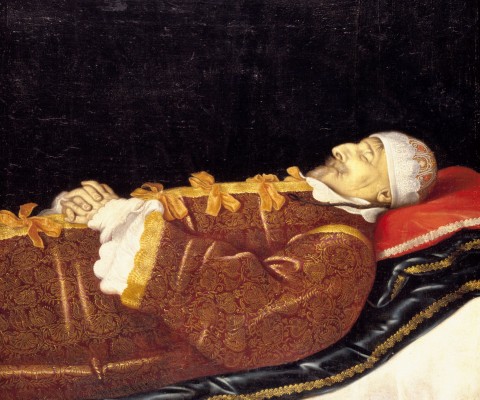
1648
Death of King Christian IV
King Christian IV of Denmark, who reigned from 1588 until his death in 1648, passed away after a tumultuous reign marked by significant architectural and cultural contributions, as well as military and territorial challenges. His death marked the end of an era for Denmark, which was left in a weakened state, struggling with the consequences of wars and loss of territories, primarily to Sweden. Christian IV's leadership had seen Denmark rise as a cultural hub but decline as a regional power.
-

1657-1660
Danish-Swedish Wars and the Treaty of Roskilde
From 1657 to 1660, Denmark engaged in two successive wars with Sweden. During the first conflict, Sweden captured significant portions of Denmark, culminating in the Treaty of Roskilde in 1658. Denmark permanently ceded Skåne, Halland, Blekinge, and several Norwegian territories to Sweden. Bornholm was also ceded but was quickly reclaimed by its inhabitants through a revolt, ensuring its return to Danish control. Later in 1658, Sweden attempted to capture all of Denmark, leading to the siege of Copenhagen. With assistance from the Netherlands, Copenhagen resisted the siege, and Sweden failed to gain further Danish territory. The treaty, however, marked a significant territorial loss for Denmark, notably affecting its control over the Øresund and diminishing its role as a power in Northern Europe.
1.4.3 ENEVÆLDEN INDFØRES
-
October 1660
Introduction of Taxation for the Danish Nobility and Shift to Hereditary Monarchy
In response to the economic downturn from wars against Sweden, King Frederik III mandated in October 1660 that the Danish nobility, who had not been of significant aid during the war, were required to start paying taxes to help rebuild the nation. This reform also included a shift to a hereditary monarchy, with the ruling king's power automatically passing to his nearest heir.
-
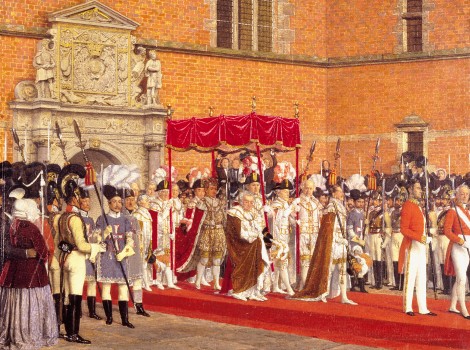
1660-61
Establishment of Absolute Monarchy in Denmark
Utilizing his newfound powers post-1660, King Frederik III overhauled the Danish governance system by instituting an absolute monarchy, termed 'enevælde'. This allowed the king to govern unilaterally, appoint officials, pass laws, and levy taxes without needing the nobility's consent, effectively centralizing the administration.
-

1665
Enactment of Kongeloven
In 1665, Denmark, under King Frederik III's rule, became the sole European monarchy to establish a written absolute monarchic law, known as Kongeloven. This law affirmed the king's almost unlimited power, delineating only minimal restrictions. It prohibited the king from dividing or relinquishing his absolute power and required the continuation of the monarchy under the Protestant faith, as established by the Reformation.
1.5 SØFARTSNATION OG KOLONIMAGT (fra ca. 1620)
-

1600s-1800s
Danish slave trade in West Africa and the Caribbean
Denmark built forts on the Gold Coast on the west coast of Africa in present-day Ghana, from where a total of over 100,000 slaves were transported to the Danish colonies in the Caribbean—Saint Thomas, Saint Croix, and Saint John. On the Danish West Indies islands, slaves were forced to work in sugarcane plantations or in the houses of European plantation owners. The sugar was then transported to Copenhagen, where it was sold either in Denmark or abroad.
-
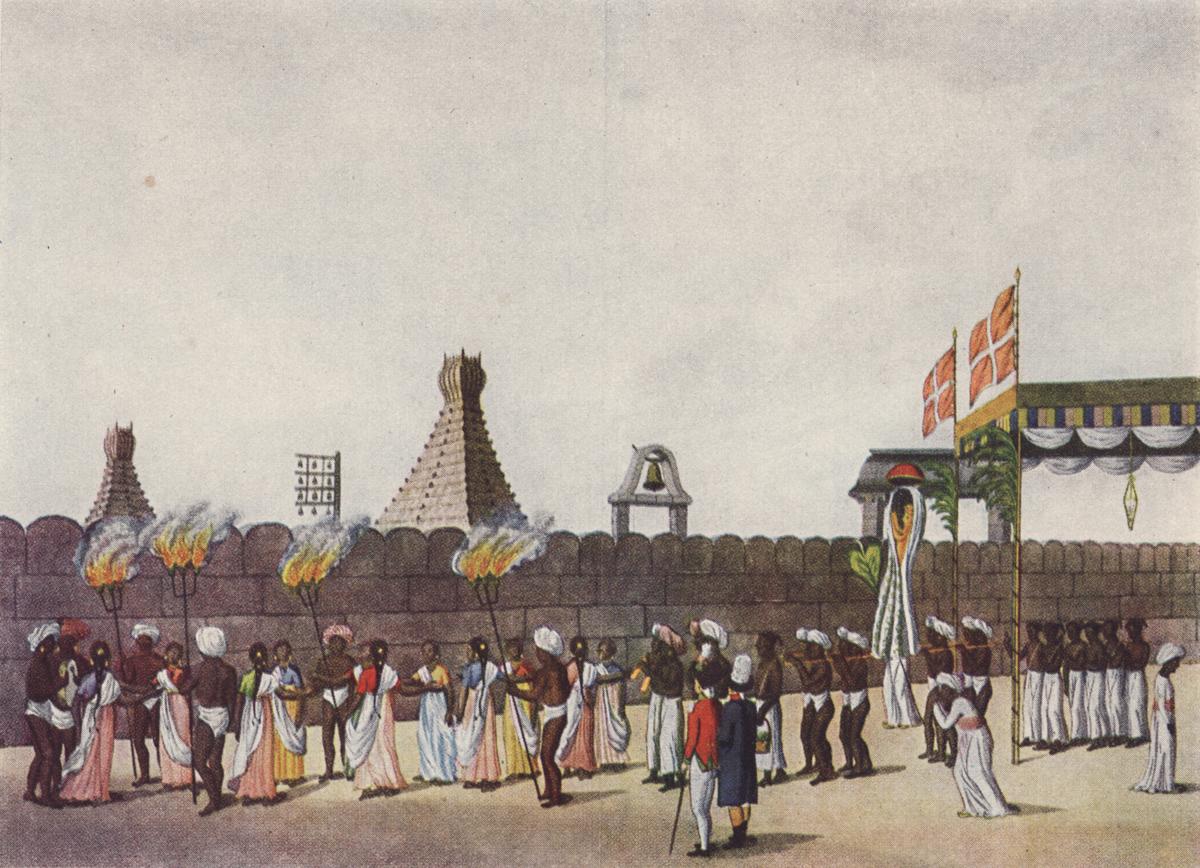
1600s-1800s
Danish trade colonies in India
Denmark also established trade colonies in Trankebar and Serampore in present-day India. From these colonies, Danish ships transported spices, saltpeter for gunpowder, cotton goods, and other valuable commodities to Europe.
-
1803
Abolition of the slave trade in Denmark
In 1803, Denmark officially banned the slave trade, ceasing the transportation of slaves to its colonies. This marked a significant policy change in response to growing international pressure and changing attitudes towards slavery in Europe. -
1848
Emancipation of slaves in Danish West Indies
In 1848, slavery was officially abolished in the Danish West Indies, freeing all slaves in the Danish colonies. This was part of a broader movement in Europe and the Americas towards the abolition of slavery. -
1721
Christian Missionaries Arrive in Greenland
From 1721, Christian missionaries, supported by the Danish king, arrived in Greenland. The primary aim was to Christianize the Greenlandic population. Additionally, there was an objective to sell products from Greenland such as seal skins, blubber, and whale meat.
-
mid-1800s
Sale of Danish Colonies in India and Ghana
In the mid-1800s, Denmark sold its colonies in India and Ghana to Great Britain. -
1917
Sale of the Danish West Indies to the USA
Denmark sold the Danish West Indies to the United States in 1917, and they are now known as the United States Virgin Islands. -
1815
Christiansted as the Principal City in the Danish West Indies
In 1815, Christiansted was the most important city in the Danish West Indies.
1.6.1 STAVNSBÅND OG LANDBOREFORMERNE
-
1700s
The Enlightenment in Denmark
The Enlightenment, a period marked by significant changes, reached Denmark, promoting ideas of enlightenment, tolerance, and critical thinking. The growing bourgeoisie in the cities began to demand a share in power and challenged the absolute monarchy. This ideological shift aimed at fostering greater freedom and improvement through reason.
-
1733
Implementation of the Stavnsbånd in Denmark
During an economic crisis in Danish agriculture in the first half of the 18th century, the Danish king introduced the Stavnsbånd in 1733. This law bound peasants, who made up the majority of the population, to the estate where they were born until they were 40 years old. This ensured a stable workforce for the estate owners, who in return had to provide some of their peasants as soldiers for the army. -
1788
Abolition of the Stavnsbånd and Agricultural Reforms in Denmark
The stavnsbånd was abolished in 1788, allowing serfs to move freely and choose where they wanted to live. This change marked the beginning of significant agricultural reforms that transformed Danish agriculture from a medieval system with serfdom to a more modern approach featuring self-owning farmers. These reforms included the privatization of land, redistribution of common lands, and relocation of farms from clustered villages to individual plots, which led to more efficient land use.
1.6.2 DEN FLORISSANTE PERIODE OG ENGLANDSKRIGE
-
Late 1700s
The Flourishing Period of Danish Maritime Commerce
During the late 18th century, known as the Flourishing Period, Danish maritime trade thrived and Copenhagen developed into an international major port. Denmark remained neutral during the wars of the time, unlike Britain, France, and the Netherlands, whose navies were engaged in warfare. The belligerent nations blocked each other's ports and sailing routes, leading to their extensive use of neutral Danish ships to transport goods. These ships carried valuable cargoes to Copenhagen, where the goods were resold to other European countries. -
1792
Denmark's Entry into the Napoleonic Wars
Initially, Denmark's neutral trade during the late 18th century brought significant revenue, but it eventually led to Denmark's involvement in the Napoleonic Wars, also known in Denmark as the English Wars. These conflicts began in 1792 following the French Revolution in 1789, with Denmark aligning with France against Britain. This involvement had disastrous consequences for Denmark. -

1801
The Battle of Copenhagen (Slaget på Reden)
In the early stages of the wars, Denmark maintained its neutrality and profited by transporting goods to both Britain and France using its large merchant fleet, protected by the Danish navy. Britain, however, was displeased with Denmark's trade with France and subsequently attacked and defeated the Danish fleet in 1801. This battle, known as the Battle of Copenhagen or Slaget på Reden, took place in the waters just outside Copenhagen's harbor, in an area known as Københavns Red.
-
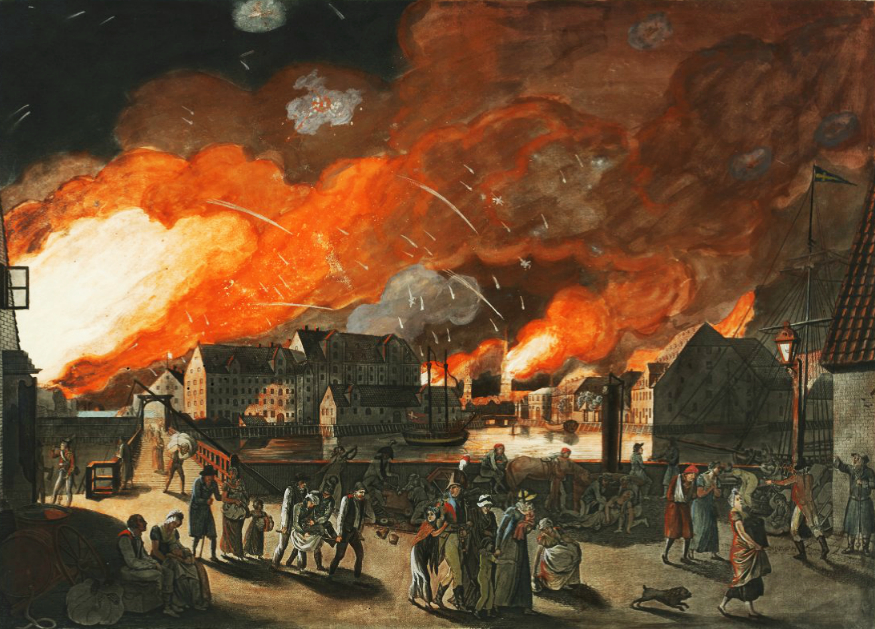
1807
Copenhagen Bombardment
In 1807, Napoleon I of France aimed to wage economic warfare against Britain by blocking trade routes with warships. To prevent Napoleon from using Danish ships for the blockade, the British opted to seize the entire Danish fleet and bombarded Copenhagen in the process. This event is known as the Copenhagen Bombardment. Following this defeat, Denmark was compelled to choose a side in the ongoing conflicts and aligned with France.
-
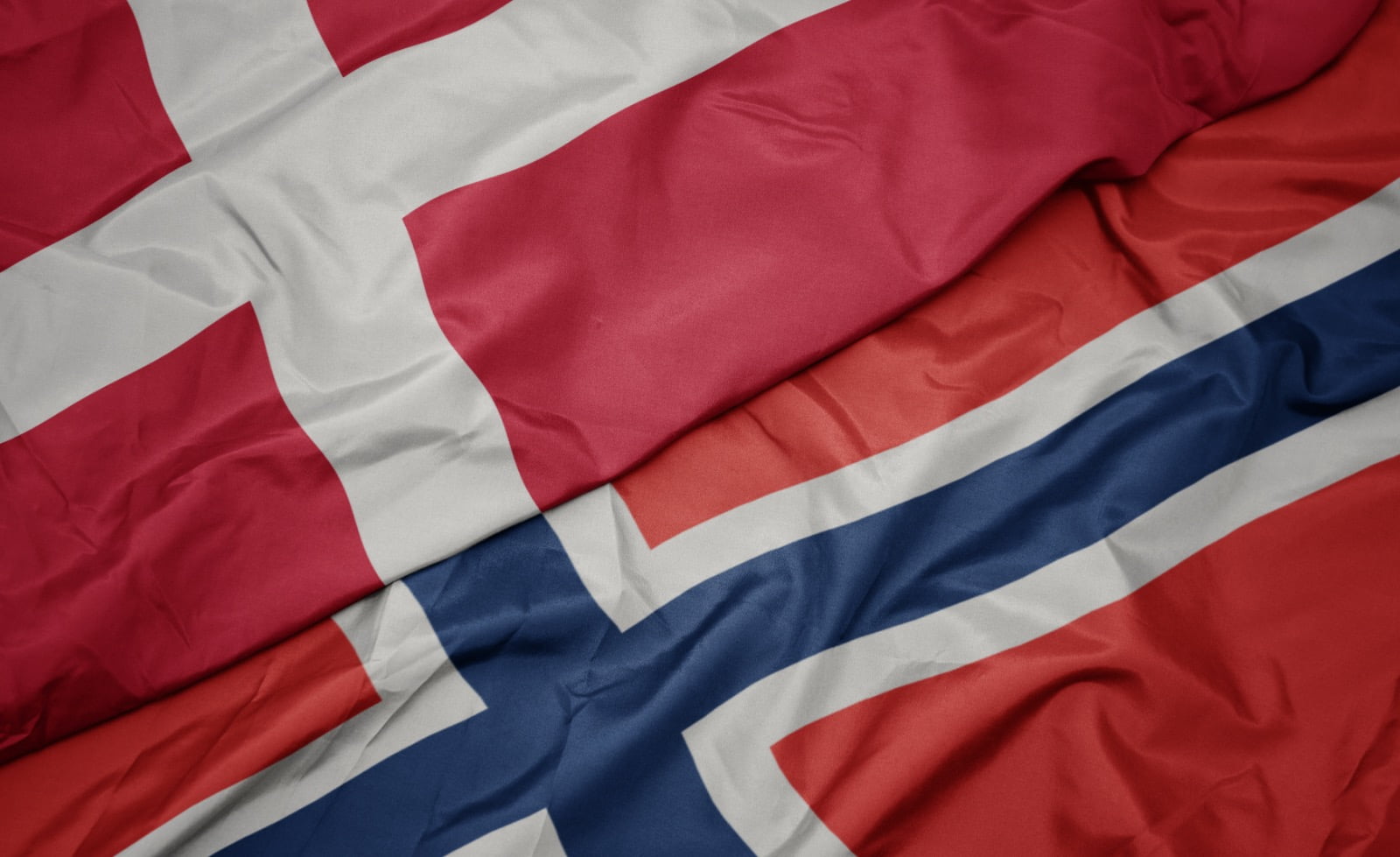
1814
End of the Danish-Norwegian Union
The Napoleonic Wars concluded with Denmark's ally, France, being defeated by other European powers. As a result, Denmark was compelled to cede Norway to Sweden under a peace treaty signed in 1814, ending over 400 years of the Danish-Norwegian union that had been established since 1380.
1.6.3 VEJEN TIL EN FRI GRUNDLOV
-
March 1848
Introduction of a Liberal Constitution in Denmark
During the 1800s, Denmark was influenced by popular and democratic movements, partly spurred by the French Revolution of 1789. Although Denmark did not experience a revolution in 1848 like many other European capitals, the unrest across Europe had a significant impact. In March 1848, the bourgeoisie in Copenhagen demanded that King Frederik VII introduce a free constitution. Faced with the agitated public mood, the king decided to comply with the demand. -
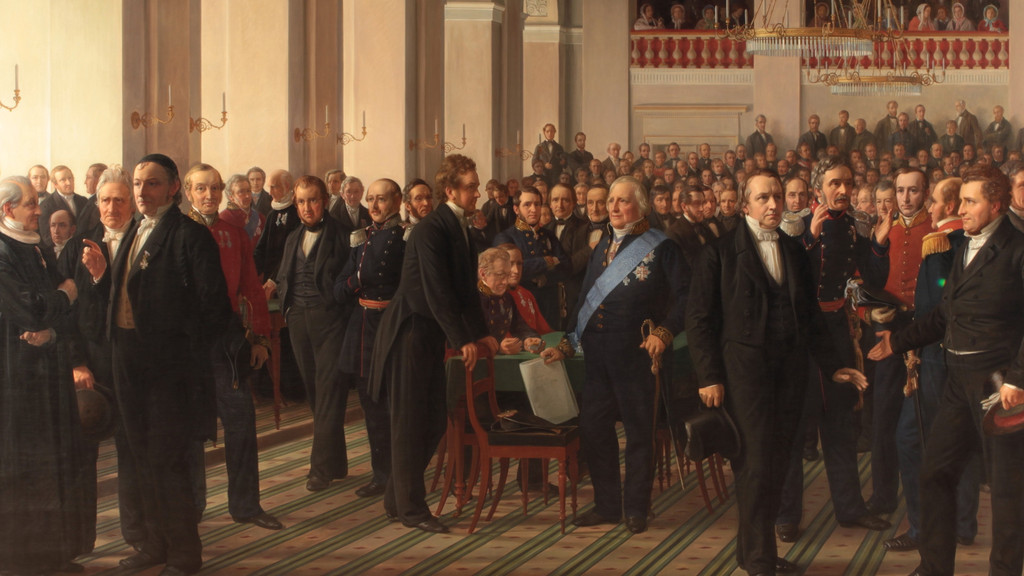
June 5, 1849
Signing of Denmark's First Free Constitution
King Frederik VII abolished the absolute monarchy in Denmark and declared himself a constitutional monarch, which meant that he would rule in collaboration with the people based on the constitution. On June 5, 1849, Frederik VII signed Denmark's first free constitution, known as 'Danmarks Riges Grundlov'. This historic act established a constitutional framework for the Danish state, aligning it with the democratic developments of the era.
-
1849
Establishment of the Danish Parliament (Rigsdagen)
Following the signing of Denmark's first free constitution in 1849, the country established a parliament, Rigsdagen, consisting of two legislative bodies: Folketinget and Landstinget. This marked a significant shift from nearly 200 years of absolute monarchy since 1660-61, granting part of the Danish population direct influence over legislation. Men over 30 years old were allowed to elect members to Rigsdagen. Candidates for Folketinget had to be at least 25 years old, while those for Landstinget needed to be at least 40 years old and have a high income. Neither women nor the poor had the right to vote or be elected to either assembly. Nevertheless, the constitution was considered very democratic and liberal compared to other nations' constitutions at the time.
1.7.1 DEN 1. SLESVIGSKE KRIG
-
Mid-1800s
The Schleswig-Holstein Question
In the mid-19th century, the Danish realm comprised the Kingdom of Denmark and the duchies of Schleswig and Holstein. The Danish king ruled over all three parts. However, increased national sentiment and democratic ideas led to tensions between the Danish-speaking and German-speaking populations. Holstein, predominantly German-speaking, naturally sought to join the German Confederation. In Schleswig, the situation was more complex with both Danish speakers wanting to remain part of Denmark and German speakers desiring to join the German Confederation along with Holstein. This dilemma became known as the Schleswig-Holstein Question. Discussions about the placement of the Danish border were prominent among people and politicians on both sides of the border. -
1848
First Schleswig War
In 1848, Schleswig and Holstein were denied their request for an independent constitution similar to the new Danish constitution. This refusal led to a civil war between the Schleswig-Holstein insurgents and Denmark. The German Confederation, supported by its most powerful member, Prussia, backed the duchies by sending a large number of troops to fight on their side. -
1848-1850
First Schleswig War (Three Years' War)
During the First Schleswig War, Denmark and the Schleswig-Holstein insurgents fought several battles between 1848 and 1850.
-
July 1849
Battle of Fredericia
In July 1849, during the First Schleswig War, the Danish army achieved a significant victory at Fredericia against the Schleswig-Holstein insurgents. This battle was crucial in bolstering the Danish morale and military stance during a series of conflicts that marked the war. The victory at Fredericia demonstrated the effectiveness of the Danish military strategies and played a key role in maintaining Danish control over the disputed territories during that phase of the war. -
July 1850
Battle of Isted
The Battle of Isted, fought in July 1850, was the bloodiest engagement of the First Schleswig War. Occurring after the withdrawal of support troops by the German Confederation and Prussia due to Russian pressure, this battle saw the Danish army achieving crucial victories. The fierce fighting resulted in significant casualties on both sides but ultimately confirmed Danish military resilience and tactical superiority in the conflict.
1.7.2 DEN 2. SLESVIGSKE KRIG
-
1863
Enactment of the Danish-Schleswig Constitution
In 1863, amidst rising national tensions and under significant public pressure, the Danish parliament passed a new constitution that included the Danish kingdom and the duchy of Schleswig, but notably excluded Holstein. This action was perceived as a violation of the previous international agreements which stipulated that Schleswig should not be treated more favorably than Holstein. The constitution aimed to integrate Schleswig more closely with Denmark, intensifying German concerns and contributing directly to the onset of the Second Schleswig War. -
February 1864
Second Schleswig War
After the First Schleswig War, Denmark had promised the great powers that it would not bind Schleswig closer to it than Holstein. However, Denmark broke this promise. In 1863, under public pressure, the Danish parliament enacted a new joint constitution for Denmark and Schleswig, but not for Holstein. This action was perceived by the German states as a breach of the previous agreement. Consequently, Prussia, led by the influential Prime Minister Otto von Bismarck, along with Austria, declared war on Denmark in February 1864. This conflict is known as the Second Schleswig War. -
February 1864
Evacuation of Dannevirke
In early February 1864, during the Second Schleswig War, the Danish forces faced a critical situation at the Dannevirke, a historic fortification line that had been a stronghold since the Viking age. Facing overwhelming Prussian forces, the Danish command made the difficult decision to evacuate Dannevirke. This strategic withdrawal was executed under harsh winter conditions and led to a significant tactical retreat into northern Jutland, marking a pivotal moment in the conflict. -
April 18, 1864
Fall of Dybbøl
On April 18, 1864, during the Second Schleswig War, the Prussian forces launched a decisive attack on Dybbøl after a prolonged bombardment. The Danish forces, significantly outnumbered and outgunned, faced a crushing defeat. This battle was a critical moment in the war, leading to the occupation of Jutland and marking a significant setback for Denmark, which would later lead to substantial territorial losses under the terms of the peace agreement.
-
1864
Consequences of the 1864 Schleswig War
The defeat in the 1864 Schleswig War was a catastrophe for Denmark, resulting in the loss of Schleswig, Holstein, and the small duchy of Lauenburg to Prussia and Austria. This loss represented about two-fifths of the Danish population and one-third of its territory. Post-war, Denmark retained only its core territories including Greenland, the Faroe Islands, and Iceland, along with the Danish West Indies until 1917. The post-war period saw a strengthening of Danish national identity, with a more homogeneous population culturally and linguistically. The loss significantly reduced Denmark’s influence in European affairs, prompting a policy of strict neutrality and a minimal military defense to ensure survival.
1.8.1 DEN FØRSTE INDUSTRIALISERING OG ARBEJDERBEVÆGELSEN
-
1847
Inauguration of Denmark's First Railway
In 1847, Denmark witnessed a significant milestone in its industrial development with the inauguration of its first railway line, connecting Copenhagen and Roskilde. This railway not only marked the beginning of railway transportation within Denmark's current borders but also symbolized a major step towards modern infrastructure and economic development. The railway facilitated increased mobility, enhanced trade capabilities, and contributed to urban growth, aligning Denmark with other industrializing nations in Europe. -
October 1871
Foundation of ’Den internationale Arbejderforening for Danmark'
In October 1871, the 'International Workers' Association for Denmark' was established as part of the broader international socialist movement. This organization aimed to unite and mobilize workers across Denmark to advocate for better working conditions, reasonable working hours, and improved workplace safety. The association played a crucial role in the early labor movement in Denmark, using newspapers and flyers to encourage workers to strike and demonstrate for better wages and conditions, reflecting a growing collective consciousness among industrial workers.
-
May 1872
Slaget på Fælleden (The Battle of Fælleden)
In May 1872, a significant conflict known as the Battle of Fælleden occurred in Copenhagen, Denmark. This event was marked by a large workers' meeting that escalated into violent clashes between demonstrating workers and the combined forces of police and soldiers. While no fatalities were reported, the confrontation led to numerous arrests. The incident underscored the ongoing labor disputes of the time, characterized by employers maintaining strict control over work management and distribution, which often resulted in strikes and conflicts.
-
1878-1884
Formation and Rise of the Social Democratic Party
The Social Democratic Party in Denmark, originally part of the broader labor movement, became an independent political entity in 1878. This transformation marked a significant development in Danish politics, reflecting the increasing organization and influence of the working class. By 1884, the party solidified its presence in Danish politics when the first two Social Democrats were elected to the Folketing, Denmark's parliament. This marked the beginning of the party's long-term impact on Danish governance and social policy. -
1878
Formation of the Social Democratic Party
In 1878, the Social Democratic Party in Denmark was established as an independent political entity, separating from the broader labor movement. This pivotal development marked the formalization of the labor movement into a structured political party aimed at representing and advancing the interests of workers within the political arena of Denmark. -
1884
First Social Democrats Elected to the Folketing
In 1884, marking a significant milestone in Danish political history, the first two members of the Social Democratic Party were elected to the Folketing, the Danish parliament. This election demonstrated the growing political influence and acceptance of the labor movement within the national legislative framework. -
September 1899
Septemberforliget
In September 1899, a prolonged dispute between employers and workers in Denmark culminated in a historic agreement known as the September Agreement, or Septemberforliget. This agreement was reached between the two main labor market organizations, known today as DA (Dansk Arbejdsgiverforening) and FH (Fagbevægelsens Hovedorganisation). The agreement affirmed employers' rights to manage and distribute work while granting workers the right to organize and represent their interests collectively through unions and representatives. This included negotiating wages, work conditions, and the right to strike under specified rules. The September Agreement still forms the basis for how agreements are made on the Danish labor market, a system referred to as 'The Danish Model.'
1.8.2 ANDELSBEVÆGELSEN
-
Mid-1870s to 1914
Transformation of Danish Agriculture and Rise of the Cooperative Movement (Andelsbevægelsen)
In the mid-1870s, Danish agriculture faced significant challenges due to the influx of cheap grain from the USA and Eastern Europe, facilitated by advancements in steamships and railways. This led to a drastic drop in grain prices, prompting Danish farmers to shift largely to animal production, notably cattle and pigs, to produce butter and bacon, which quickly became Denmark's primary export items. The UK became the main market for these products, absorbing over half of the animal food exports between 1890 and 1914. Concurrently, the Danish cooperative movement, inspired by England's Co-operative Movement of the 1840s, gained momentum. Farmers united to establish dairies and consumer cooperatives, collaborating on purchasing and production, and sharing profits based on each member's sales. This period also saw the establishment of cooperative slaughterhouses, enhancing farmers' control over both production and marketing of their meat. The cooperative movement (andelsbevægelsen) played a crucial role in the development of Danish agriculture and the broader societal shift towards democratic principles and equality, principles that have become integral to modern Danish society.
1.8.3 PARLAMENTARISMENS GENNEMBRUD
-
1866
Amendment of the Danish Constitution
In 1866, following the military and political defeat in the 1864 war, conservative forces backed by the landowning class successfully pushed for a constitutional amendment in Denmark. This amendment marked a democratic setback by granting the king and the wealthiest men the power to elect most seats in the Landstinget, one of the chambers of the Rigsdag, while a somewhat broader access to vote was preserved for the Folketinget. This change intensified the political struggle, reflecting a division in the electoral bases of the two legislative bodies. -
1870
Formation of Højre and Venstre Parties
Around 1870, in response to ongoing constitutional conflicts known as 'The Constitutional Struggle', Danish political factions organized into two main parties: Højre, representing conservative interests and the upper classes, and Venstre, representing farmers and advocating for broader democratic reforms. Venstre gained a majority in the Folketing, while Højre, led by J.B.S. Estrup, maintained control of the Landstinget. This period was marked by political deadlock and frequent use of provisional laws by the conservative government despite their minority status in the Folketing. -
1901
Systemskiftet: Introduction of Parliamentary Democracy in Denmark
In 1901, the longstanding political deadlock was broken with the introduction of the parliamentary principle, signifying a pivotal shift in Danish democracy. This principle, officially integrated into the Danish constitution in 1953, mandates that a government cannot hold power without a majority in the Folketing. The Systemskiftet marked the end of monarchic and conservative dominance, allowing Venstre to take government control for the first time, fundamentally changing the political landscape in Denmark.
1.8.4 KVINDEBEVÆGELSEN
-
1871
Foundation of Dansk Kvindesamfund
In 1871, Dansk Kvindesamfund, Denmark's oldest women's organization, was founded. This organization played a pivotal role in advocating for women's rights and was instrumental in achieving significant advancements for women in Denmark throughout the early 20th century. -
1875
Women Gain Access to University Education
In 1875, women in Denmark were granted the right to take the studentereksamen and to attend university, marking significant progress in educational equality. Initially, these exams could only be taken at private girls' schools until 1903, when public gymnasia were opened to women.
-
1903
Women's right to vote for Folk Church Councils
In 1903, Danish women achieved a significant milestone by obtaining the right to vote in folk church councils. This initial step towards suffrage represented the gradual recognition of women's roles in public and religious life, setting a precedent for further rights.
-
1915
Women's right to vote in parliament elections
In 1915, a pivotal change occurred in Danish democracy as the constitution was amended to grant women full suffrage rights. This amendment, which came into effect in 1918, allowed women to vote and stand as candidates in elections for both chambers of the Rigsdag, aligning Denmark with the progressive movements in Europe and establishing gender equality in the electoral process.